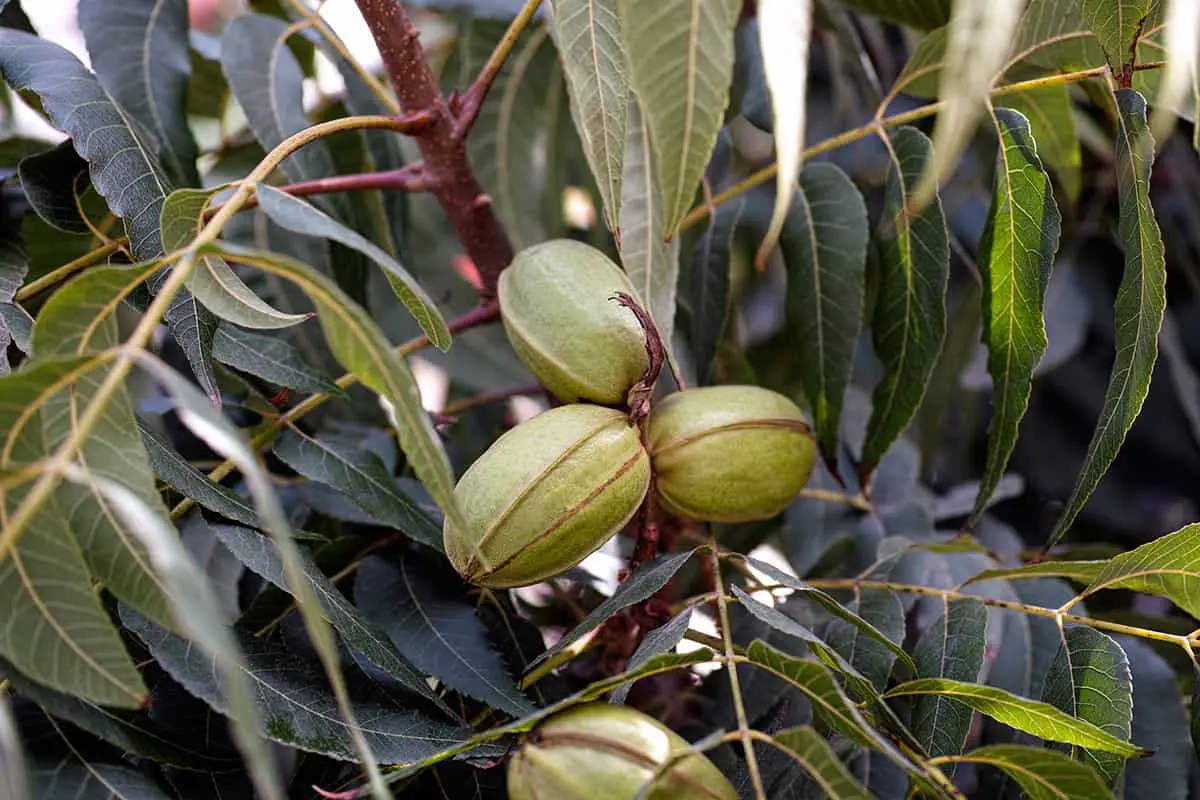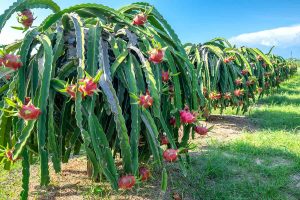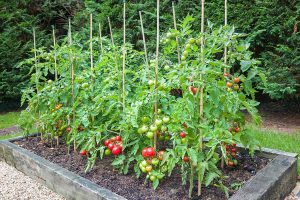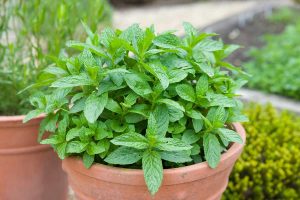The pecan tree is a deciduous tree that grows natively in North America, primarily in the areas which surround the Mississippi river. This tree is commercially and historically significant for the United States, which is by far the largest producer of pecan nuts. In fact, the US is accountable for over 80% of pecan production across the world.
Each year, the US harvests between 200 and 300 million tonnes of pecans, with Georgia being the biggest producer, typically harvesting around 88 million tonnes of the nuts in a single year. Other states who are important pecan producers are Texas and New Mexico, along with Florida, Arizona, Alabama, and Louisiana.
The pecan tree has cultural significance in Texas, where the pecan tree is named as the state tree, and the pecan nut is named as the state nut.
Pecan trees are long-lived trees that typically start producing harvests when they are between 10 and 15 years old, and they will continue to produce pecan nuts for the rest of their lives, usually to 200 or 300 years. Pecan trees can grow to heights of up to 100 feet, and in some cases, they can even exceed 150 feet.
There are over 1000 different varieties of pecan trees available, which produce specific varieties of pecan nuts. Not all pecan trees require the same care conditions, so it’s important to select a tree well suited to your local climate if you want to produce pecans at home.
Table of Contents
Pecan Tree Varieties
Choctaw Pecan
- Botanical name: Carya illinoinensis ‘Choctaw’
- Common names: Choctaw Pecan, Northern Pecan
- Plant family: Juglandaceae
- USDA hardiness zone: 6 – 9
- Mature height: 40 feet
- Mature spread: 30 feet
The Choctaw pecan tree is among the smaller types of pecan trees, making it a good choice for smaller farms. It grows well in most areas where pecans are grown, and is easy to care for providing the drainage is good. The pecan nuts this tree produces are quite large, with a thin hull that makes them easy to shell.
The nuts have a high oil content, making them delicious for eating fresh, as well as in pies. The nuts will be ready to harvest from the tree from mid to late fall. As a specimen itself, the Choctaw pecan tree is great for creating shade. It has an upright growth habit which forms an oval canopy when mature. The foliage is dense and rich, making for a beautiful addition to the landscape.
Caddo Pecan
- Botanical name: Carya illinoinensis ‘Caddo’
- Common names: Caddo Pecan
- Plant family: Juglandaceae
- USDA hardiness zone: 6 – 10
- Mature height: 75 to 100 feet
- Mature spread: 60 feet
The Caddo pecan tree is a hybrid species that was created in the 1920s as a result of cross-pollinating the ‘Alley’ and ‘Brooks’ cultivars. It was released by the USDA breeding programme in 1968, following research at Brownwood, Texas. It is a large variety, which is known to have excellent resistance to disease, and a high production of pecan nuts. The yield rate of this tree is 67 nuts per lb, and they will be ready to harvest in mid-fall.
The foliage of this tree is dark and lush, making it an attractive specimen tree. The Caddo pecan tree starts to produce nuts at around 5 years of age, and it will continue to reliably produce large harvests year after year. It is suitable for growing in any pecan-growing region and has a good tolerance for high and low temperatures. Grow it in full sun and ensure excellent drainage.
Desirable Pecan
- Botanical name: Carya illinoinensis ‘Desirable’
- Common names: Desirable Pecan
- Plant family: Juglandaceae
- USDA hardiness zone: 6 – 9
- Mature height: 70 feet to 100 feet
- Mature spread: 50 feet to 80 feet
The nuts produced by the Desirable pecan are considered as the gold standard among many in the pecan industry. While the tree can take as long as 10 years to start producing pecans, once it does start to yield harvests it will do so reliably for many years. The nuts of this tree are exceptionally large, attractive, and delicious.
Desirable pecans are able to demand the highest prices compared to other varieties of pecan. This tree is more tolerant of high humidity than most, so it is ideal for humid climates where other types of pecan trees may struggle. In most commercial orchards, such as those in Georgia which is the main pecan producer in the US, the ‘Desirable’ cultivar is the main type of pecan tree that is grown.
Western Pecan
- Botanical name: Carya illinoinensis ‘Western’
- Common names: Western Pecan, Western Schley Pecan
- Plant family: Juglandaceae
- USDA hardiness zone: 7 – 9
- Mature height: 60 feet to 80 feet
- Mature spread: 60 feet to 80 feet
The Western pecan is a popular variety for beginner growers because it is easy to care for and reliably produces high quality nuts. The nuts of this tree tend to be small in size, but consistently delicious. This tree should only be grown in dry climates since it is very susceptible to downy spot and scab disease, which thrive in humid conditions. The incidence of these diseases will be much lower when the tree is grown in a dry climate.
Elliot Pecan
- Botanical name: Carya illinoinensis ‘Elliot’
- Common names: Elliot Pecan
- Plant family: Juglandaceae
- USDA hardiness zone: 7 – 10
- Mature height: 50 feet to 100 feet
- Mature spread: 35 feet to 50 feet
The Elliot pecan tree is renowned for its high resistance to scab disease. It is suitable for planting in climates with high humidity, even with no additional scab protection. Because of this, it is one of the most popular varieties among home growers. The nuts produced by this tree are of very high quality and therefore demand a high price.
They are perfectly tear-drop shaped, and have a distinct hickory taste, though the tree can take many years to yield significant harvests. This variety of pecan is predominantly grown throughout Florida and Georgia. It struggles when faced with freezing conditions, so be sure to grow it in warmer climates that do not freeze over winter.
Grow the Elliot pecan in full sun, in any type of well-draining soil. Once well established, this variety of pecan is highly tolerant of drought.
Kanza Pecan
- Botanical name: Carya illinoinensis ‘Kanza’
- Common names: Kanza Pecan
- Plant family: Juglandaceae
- USDA hardiness zone: 5 – 9
- Mature height: 75 feet to 100 feet
- Mature spread: 60 feet to 80 feet
The Kanza pecan tree was developed by the USDA alongside the Agricultural Experiment Stations of Alabama, Georgia, Louisiana and Texas, as a cold hardy variety suitable for growing in more northern climates. It is a result of a cross between the ‘Major’ and ‘Shoshoni’ varieties and was released to the public in 1996.
The nuts produced by this tree are remarkably similar in size, shape, and color to the Elliot pecans. In fact, most people would be unable to tell the difference between the two nuts. In northern climates where the Elliot pecan tree would be unable to survive cold snaps, the Kanza pecan tree is recommended as the best alternative.
Pawnee Pecan
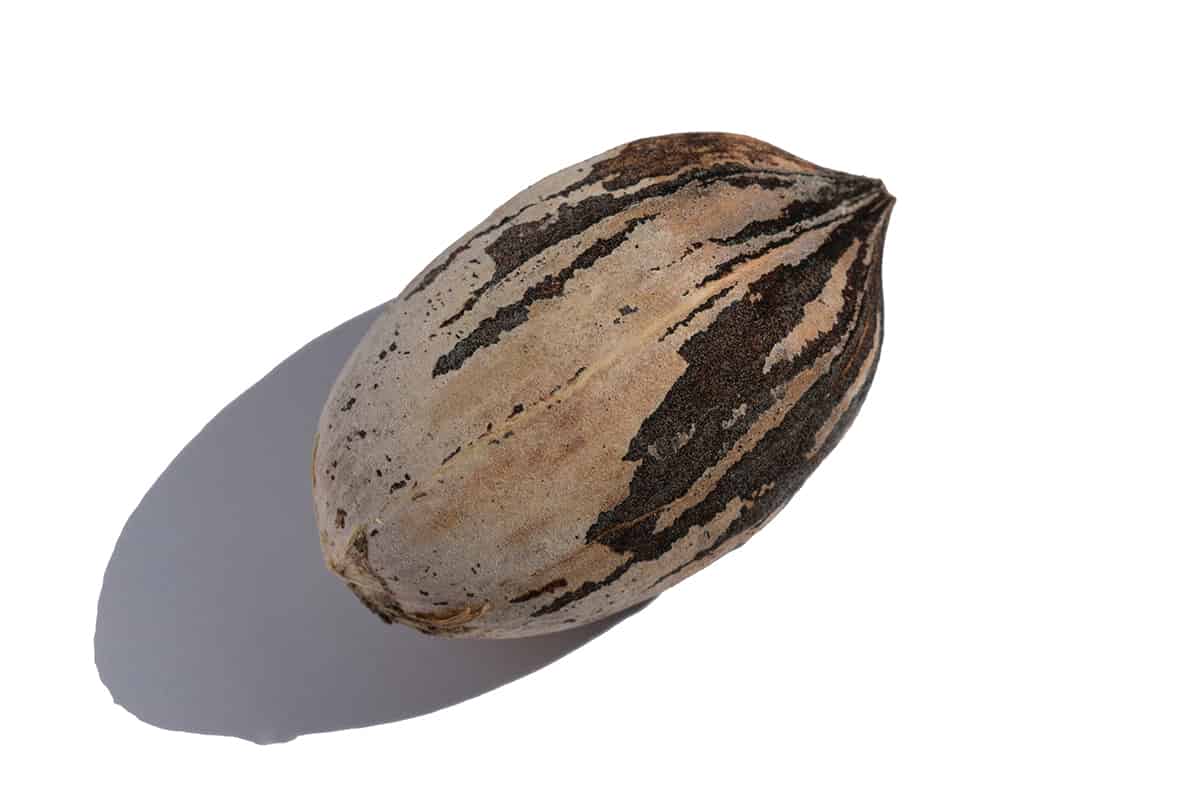
- Botanical name: Carya illinoinensis ‘Pawnee’
- Common names: Pawnee Pecan
- Plant family: Juglandaceae
- USDA hardiness zone: 6 – 9
- Mature height: 30 feet
- Mature spread: 15 feet to 25 feet
This is a smaller pecan tree that is known for the large nuts it produces and its early harvest time. The nuts will typically be ready to harvest in the third week of September, which is several weeks earlier than most other types of pecan trees, and often there will be some nuts on the tree bursting open from the very beginning of September.
Unfortunately, the Pawnee pecan is highly susceptible to scab disease, so it should be grown in climates with low humidity levels, or be treated with preventative fungicide. Nut yields for this tree are known to be low until the plant reaches around 10 years of age, at which point the harvests will become more sizable.
Mandan Pecan
- Botanical name: Carya illinoinensis ‘Mandan’
- Common names: Mandan Pecan
- Plant family: Juglandaceae
- USDA hardiness zone: 6 – 9
- Mature height: 75 to 100 feet
- Mature spread: 50 to 80 feet
This is a relatively new variety of pecan trees that was released in 2009 by the USDA. It is favored for its high yield potential, good quality of nuts, and resistance to scabs.
The nuts of the Mandan pecan tree are ready to harvest early in the season, which also add to its popularity. It is suitable for growing in any pecan-growing region.
Pecan Tree Care
Planting
Give your pecan tree the best start in life by planting it with care and knowledge. Pecan trees are best planted in pairs or greater numbers so that they can cross-pollinate to produce nuts. Since these trees grow to exceptional sizes, you need to plant the trees far enough away from each other that they have space to thrive, yet close enough together to encourage cross-pollination.
Ideally, each pecan tree should be between 60 and 80 feet from the next pecan tree. When planting a pecan tree sapling you’ll notice that the plant has a long tap root. This tap root is vital to the survival of the tree, so treat it with extra care. Often the taproot will have circled around the bottom of the container it has been growing in, and you’ll need to straighten this out before you set it into its permanent spot in the ground.
The taproot needs to be pointing vertically straight down, so you’ll have to dig a deep hole to accommodate this. If the tap root is longer than the hole you can dig, cut off the bottom of the tap root rather than swirl it around. Any dead or damaged roots on the tree should also be removed before planting. Once set in the hole you have made for it, cover the roots over with soil and water the plant thoroughly to help it adjust to its new setting.
Water
Pecan trees require consistent moisture, especially when they are young. You can expect to water them deeply around once a week throughout spring and summer unless there has been rain.
Through fall and winter, the pecan tree should be able to survive on rainfall alone. As it becomes more established, the pecan tree will not be so heavily reliant on frequent watering, though it does still prefer to grow in moderately moist soil. This tree is not able to survive in soggy or wet soils, as the roots are susceptible to rot when grown in these conditions.
Ensure the pecan tree is grown in soil that is well-draining, to encourage any excess moisture to drain away from the roots. Planting a pecan tree on a hill is a good idea because it means water won’t pool around the base of the tree.
Light
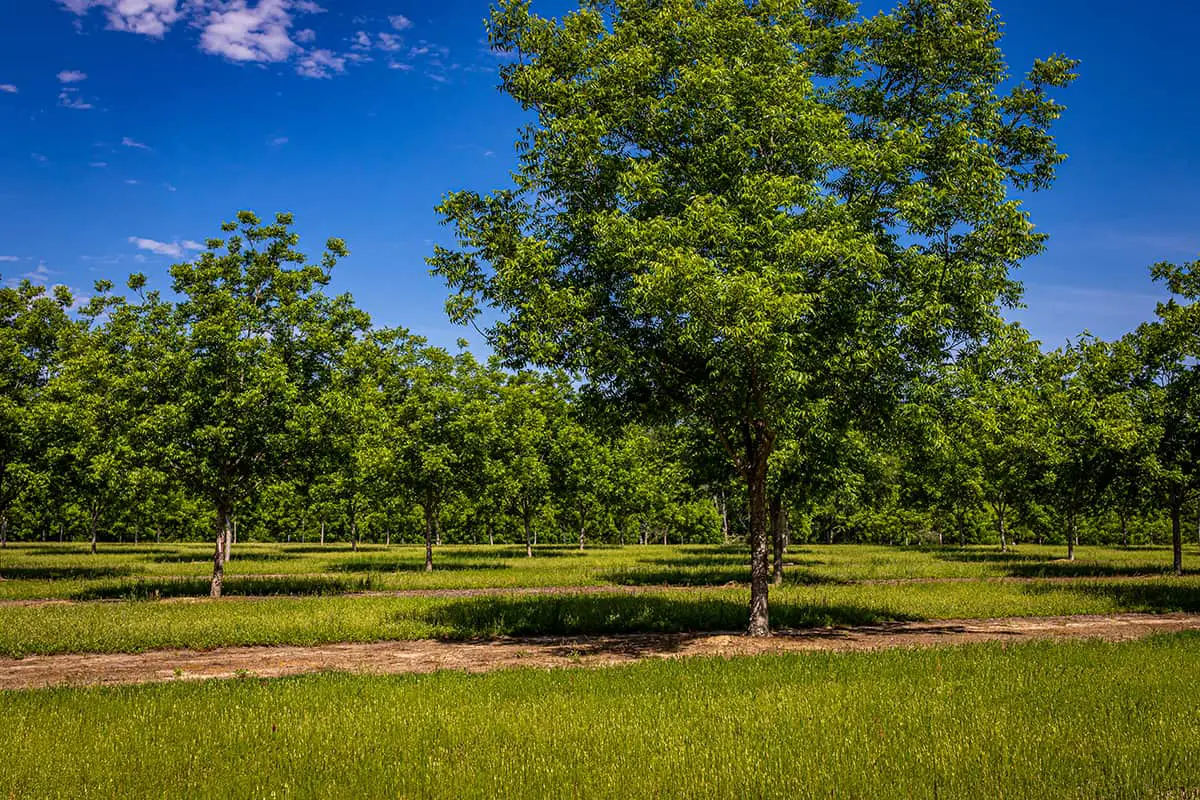
Pecan trees thrive in full sun. Due to their size, they should not be planted close to other trees or buildings, and this also means that they won’t be shaded by other nearby structures. Pecan trees will perform best in areas that have long daylight hours, and long sunny seasons.
Temperature
Most pecan trees thrive in USDA hardiness zones 7 to 9, but some varieties can be grown in zones as low as 5, or up to 10. In general, the ideal temperature for a pecan tree is around 70°F. In the colder months, pecan trees should not ideally be kept in temperatures any lower than 45°F, however, some varieties will withstand short periods of below-freezing temperatures.
If you live in a climate that experiences freezing temperatures, be sure to seek out a more cold hardy pecan tree. When it comes to hot temperatures, pecan trees enjoy high levels of heat but cannot tolerate extremes. They prefer not to be subjected to temperatures any higher than 80°F during summer, though some varieties are more tolerant of high heat levels than others.
